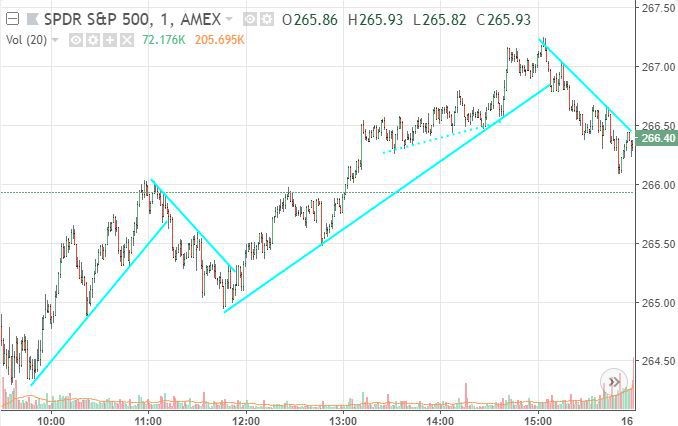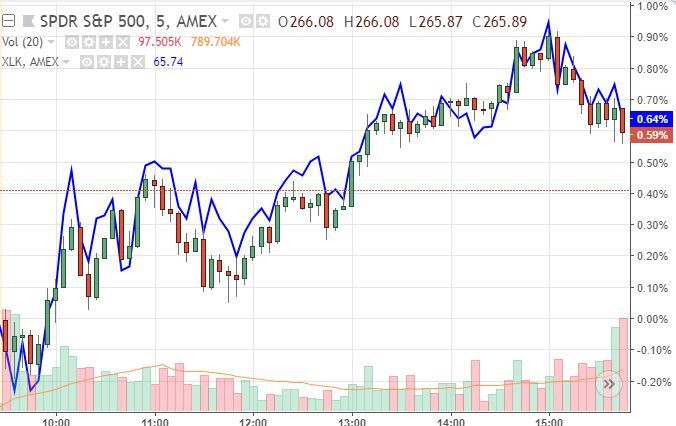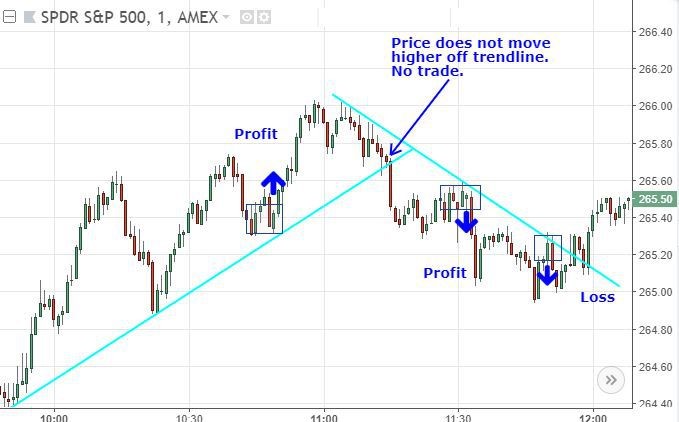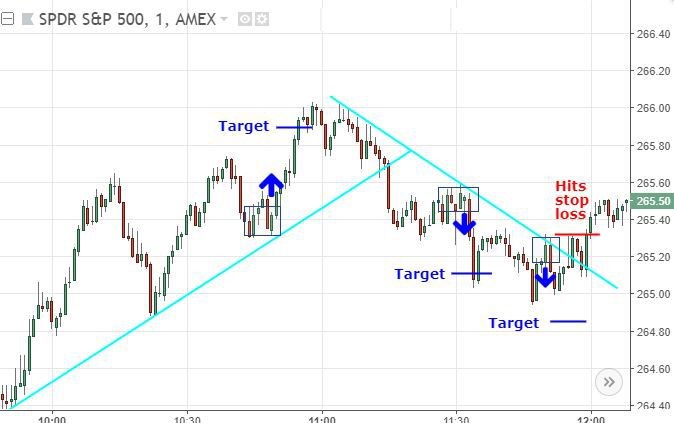1) High Liquidity.
Liquid stocks have big volume, whereby larger quantities can be purchased and sold without significantly affecting the price. Since intraday trading strategies depend on speed and precise timing, a lot of volume makes getting into and out of trades easier. Depth is also critical, which shows you how much liquidity a stock has at various price levels above or below the current market bid and offer.
2) Medium to High Volatility.
Day traders require price movement in order to make money. Day traders can choose stocks that tend to move a lot in dollar terms or percentage terms, as these two filters will often produce different results. Stocks that tend to move 3% or more per day have consistent large intraday moves to trade. The same is true for stocks that tend to move more than $1.50 per day.
3) Group Followers.
While there are those who specialize in contrarian plays, most traders look for equities that move in correlation with their sector and index group. This means that, when the index or the sector tick upward, the individual stock's price also increases. This is important if the trader wants to be trading the strongest or weakest stocks each day (discussed in more detail later). If a trader opts to trade the same stock every day, it is wise to focus on that one stock and there is no need to worry about whether it is correlated with anything else.
However, day trading is risky and requires knowledge, skill, and discipline. If you are looking to make a big win by betting your money on your gut feelings, try the casino.
The Entry and Exit Strategies
You may have picked the sweetest stock in the world, but profiting from it will rely on strategies. Intraday strategies are as numerous as traders themselves, but by sticking to certain guidelines and looking for certain intraday trading signals, you are more likely to succeed.
Here are five such guidelines.
1. Trade only with the current intraday trend.
The market always moves in waves, and it is the trader's job to ride those waves. During an uptrend, focus on taking long positions. During a downtrend, focus on taking short positions. Intraday trends do not continue indefinitely, but usually one or two trades, and sometimes more, can be made before a reversal occurs. When the dominant trend shifts, begin trading with the new trend.
Isolating the trend can be the difficult part. Trendlines provide a simple and useful entry and stop-loss strategy. The following chart of the SPDR S&P 500 (SPY) shows several short-term trends during a typical day.

More trendlines can be drawn while trading in real time to see the varying degrees of each trend. Drawing in more trendlines may provide more signals and may also provide greater insight into the changing market dynamics.
2. Trade strong stocks in an uptrend, weak stocks in a downtrend.
To choose the best stocks for intraday trading, most traders will find it beneficial to look at equities or ETFs that have at least a moderate to high correlation with the S&P 500 or Nasdaq indexes and then isolate those stocks that are relatively weak or strong compared to the index. This creates an opportunity for the day trader, because a strong stock may move up 2% when the index moves up 1%. There is more opportunity in the stock that moves more.
When the indexes/market futures are moving higher, traders should look to buy stocks that are moving up more aggressively than the futures. When the futures pull back, a strong stock will not pull back as much, or may not even pull back at all. These are the stocks to trade in an uptrend, as they lead the market higher and thus provide more profit potential.
When the indexes/futures are dropping, it can be profitable to short sell stocks that drop more than the market. When the futures move higher within the downtrend, a weak stock will not move up as much, or will not move up at all. Weak stocks provide greater profit potential when the market is falling.
The stocks and ETFs that are stronger or weaker than the market may change daily, although certain sectors may be relatively strong or weak for weeks at a time.
The following chart compares the SPDR S&P 500 to the SPDR Select Technology Fund (XLK). The blue line, XLK, was relatively strong compared to SPY. Both ETFs moved higher throughout the day, but because XLK had such large gains on rallies and slightly smaller declines on pullbacks, it was a market leader and outperformed SPY on a relative basis. If you are going to buy something, buy the thing that is strongest.

The same is true to short trades. Short sellers should isolate stocks or ETFs that are relatively weak. In this way, when prices fall, you are likely to be in stocks or ETFs that will fall the most, thus increasing the profit potential of the trade.
3. Be patient; wait for the pullback.
Trendlines are an approximate visual guide for where price waves will begin and end. Therefore, in selecting stocks for intraday trading, we can use a trendline for early entry into the next price wave in the direction of the trend.
When entering a long position, buy after the price moves down toward the trendline and then moves back higher. To draw an upward trendline, a price low and then a higher price low is needed. The line is drawn connecting these two points and then extended out to the right. On the chart below, the price bounces off the trendline a couple of times before the price falls through it the third time.

Short selling in a downtrend would be similar. You should wait until the price moves up to the downward-sloping trendline, then when the stock begins to move back down, you use this as a trading signal to make your entry.
By being patient, these two long trades provide a low-risk entry. The purchase is made close to the stop-loss level, which would be placed a few cents below the trendline or the most recent price low made just prior to entry. As mentioned previously, trends don't continue indefinitely, so there will be losing trades. But as long as an overall profit is made, even with the losses, that is what matters. Research conducted by Proquest shows that the number of day traders who are profitable after all associated costs is around 36%
4. Take regular profits.
Day traders have limited time to capture profits and must, therefore, spend as little time as possible in trades that are losing money or moving in the wrong direction.
Here are two simple guidelines that can be used to take profits when trading with trends.
- In an uptrend or long position, take profits at or slightly above the former price high in the current trend.
- In a downtrend or short position, take profits at or slightly below the former price low in the current trend.
In the chart below, entries and exits are marked. The chart shows that, as the trend continues higher, the price pushes through past highs, which provide an exit for each respective long position taken. The same method can be applied to downtrends; profits are taken at or slightly below the prior price low in the trend.

5. When the market stalls, don't play.
Markets don't always trend. Sometimes, intraday trends reverse so often that an overriding direction is hard to establish. If major highs and lows are not being made, make sure the intraday movements are large enough for the potential reward to exceed the risk. For example, if risking $0.10 per share, the stock or ETF should be moving enough to give you at least a $0.15 to $0.20 profit using the guidelines above.
If the price is moving in a range (not trending), switch to a range-bound trading strategy. During a range, our drawn lines will be horizontal, not angled. The same general concepts apply though. Buy when the price moves to the lower horizontal area, (support) and then starts moving higher. Short sell when the price reaches the upper horizontal line, (resistance) and starts to move lower again.
When buying, look to exit near the top of the range, but not right at the top. When shorting, look to exit in the lower portion of the range, but not right at the bottom. The potential reward should be greater than the risk. Place a stop-loss just below the most recent low prior to entry on a buy signal, or just above the most recent high prior to entry on a short signal.
It can be hard for many traders to alternate between trend trading and range trading. Therefore, many traders opt to do one or the other. If trend trading, step aside when markets are ranging and focus on trading stocks or ETFs that tend to trend. If range trading, avoid trading during trends and focus on trading stocks or ETFs that tend to range.
In Summary
Identifying the right stocks for Intraday trading involves isolating the current market trend from surrounding noise and then capitalizing on that trend. Certain features – liquidity, volatility and correlation – characterize the best intraday trading stocks, but it's also important to apply the right entry and exit strategies. Studying trendlines and charting price waves can aid in this endeavor. There are many ways to trade and none of them work all the time. That is why sometimes it is just best not play and if the conditions aren't providing a good environment for deploying your strategies, save your money for when they are.
Cory Mitchell can be contacted at Vantage Point Trading
